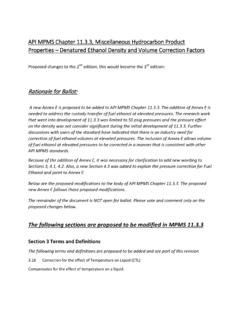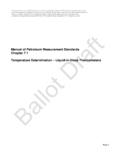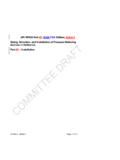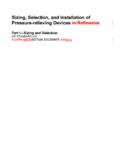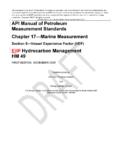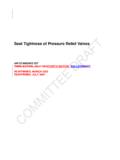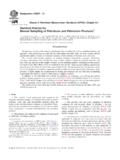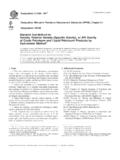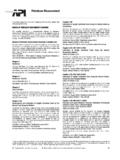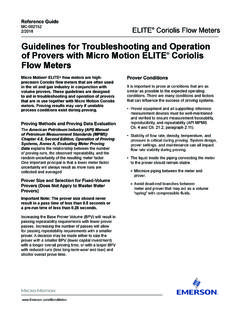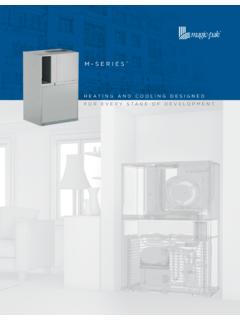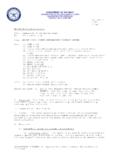Transcription of API MPMS Chapter 18.2 Custody Transfer of Crude …
1 API mpms Chapter Custody Transfer of Crude Oil from lease tanks using Alternative measurement methods 1ST EDITION, DATE. Foreword Nothing contained in any API publication is to be construed as granting any right, by implication or otherwise, for the manufacture, sale, or use of any method, apparatus, or product covered by letters patent. Neither should anything contained in the publication be construed as insuring anyone against liability for infringement of letters patent. Shall: As used in a standard, shall denotes a minimum requirement in order to conform to the specification. Should: As used in a standard, should denotes a recommendation or that which is advised but not required in order to conform to the specification. This document was produced under API standardization procedures that ensure appropriate notification and participation in the developmental process and is designated as an API standard.
2 Questions concerning the interpretation of the content of this publication or comments and questions concerning the procedures under which this publication was developed should be directed in writing to the Director of Standards, American Petroleum Institute, 1220 L Street, , Washington, 20005. Requests for permission to reproduce or translate all or any part of the material published herein should also be addressed to the director. Generally, API standards are reviewed and revised, reaffirmed, or withdrawn at least every five years. A one-time extension of up to two years may be added to this review cycle. Status of the publication can be ascertained from the API Standards Department, telephone (202) 682-8000. A catalog of API publications and materials is published annually by API, 1220 L Street, , Washington, 20005. Suggested revisions are invited and should be submitted to the Standards Department, API, 1220 L Street, NW, Washington, 20005, This document is not an API Standard; it is under consideration within an API technical committee but has not received all approvals required to become an API Standard.
3 It shall not be reproduced or circulated or quoted, in whole or in part, outside of API committee activities except with the approval of the Chairman of the committee having jurisdiction. Copyright API. All rights reserved Contents 1. Scope 2. Normative References 3. Definitions 4. Safety 5. Selection of methods for Quantity and Quality Determinations using Available Equipment in Zones 6. General Responsibilities for Production Operators and Crude Oil Truck Drivers 7. Maintenance and Calibration of Equipment 8. Assessing Oil Merchantability Prior to Loading 9. measurement Equipment for the Trailer Zone 10. measurement Equipment for the Transition Zone 11. measurement Equipment for the Tank Zone 12. Record Keeping 13. Capability and Uncertainty 14. Run Tickets and Tank Turndowns Annex A (informative). Annex B (informative). Annex C (normative). INTRODUCTION.
4 The API Manual of Petroleum measurement Standards covers individual standards for sampling, temperature determination, gauging, and quality testing. This publication integrates these standards, by reference, into a framework that may be applied during Custody Transfer of Crude oil from lease tanks to a tank truck without requiring direct access to the tank thief gauge hatch. Many of the individual standards have guidelines defining the frequency and tolerances for installation, verification, and calibration of the specified equipment under controlled or ideal conditions allowing for uncertainty within Custody Transfer requirements. However, with the conditions encountered in many of today's applications, the installation, verification, and calibration of measurement devices may have higher uncertainties due to the operational characteristics and limited access available at the lease site.
5 In the interest of safety and environmental concerns, these higher uncertainties may still provide acceptable measurement for Custody Transfer of Crude oil from tanks using the defined alternate methods . This document is not an API Standard; it is under consideration within an API technical committee but has not received all approvals required to become an API Standard. It shall not be reproduced or circulated or quoted, in whole or in part, outside of API committee activities except with the approval of the Chairman of the committee having jurisdiction. Copyright API. All rights reserved API mpms Chapter Custody Transfer of Crude Oil from lease tanks using Alternative measurement methods 1 Scope This standard defines the minimum equipment and methods used to determine the quantity and quality of oil being loaded from a lease tank to a truck trailer without requiring direct access to a lease tank gauge hatch.
6 methods and equipment described are grouped by tank zone, trailer zone, and the transition zone between the two. The equipment used for measurement is dependent on the existing design of the lease equipment, the equipment used to transport the product or a combination of the two. Some sites may require measurements from multiple zones in order to arrive at an accurate load quantity and quality. 2 Normative References The following referenced documents are indispensable for the application of this document. For dated references, only the edition cited applies. For undated references, the latest edition of the referenced document (including any amendments) applies. API mpms Chapter 2, Tank Calibration All relevant sections API mpms Chapter , Standard Practice for the Manual Gauging of Petroleum and Petroleum Products API mpms Chapter , Standard Practice for Level measurement of Liquid Hydrocarbons in Stationary tanks by Automatic Tank Gauging API mpms Chapter , measurement of Liquid Hydrocarbons by Hybrid Tank measurement Systems API mpms Chapter 4, Proving Systems All relevant sections API mpms Chapter , measurement of Liquid Hydrocarbons by Displacement Meters API mpms Chapter , measurement of Liquid Hydrocarbons by Turbine Meters API mpms Chapter , measurement of Liquid Hydrocarbons by Coriolis Meters API mpms Chapter , measurement of Liquid Hydrocarbons by Ultrasonic Flow Meters API mpms Chapter 7, Temperature Determination All relevant sections API mpms Chapter .
7 Standard Practice for Automatic Sampling of Liquid Petroleum and Petroleum Products API mpms Chapter 9, Density Determination All relevant sections API mpms Chapter 10, Sediment and Water All relevant sections This document is not an API Standard; it is under consideration within an API technical committee but has not received all approvals required to become an API Standard. It shall not be reproduced or circulated or quoted, in whole or in part, outside of API committee activities except with the approval of the Chairman of the committee having jurisdiction. Copyright API. All rights reserved API mpms Chapter , Volume Correction Factors API mpms Chapter 12, Calculation of Petroleum Quantities All relevant sections API mpms Chapter 13, Statistical Aspects of Measuring and Sampling API mpms Chapter , Mass measurement of Liquid Hydrocarbons in Vertical Cylindrical Storage tanks by Hydrostatic Tank Gauging API mpms Chapter , Electronic Liquid Volume measurement using Positive Displacement and Turbine Meters API mpms Chapter , Testing Protocols Differential Pressure Flow measurement Devices 3 Definitions For the purposes of this document, the following definitions apply.
8 Automatic Tank Gauge (ATG). An instrument that automatically measures and displays liquid levels or ullage in one or more tanks either continuously, periodically, or on demand. Crude Oil Truck Driver (COTD). Assumes that the driver is also the gauger; however, it should be recognized that these duties may be divided between two individuals: a person who only drives the tank truck and a gauger who is responsible for measurement and testing. Hydrostatic Tank Gauging (HTG). A method of direct measurement of liquid mass in a storage tank based on measuring static pressures caused by the liquid head above the pressure sensor Merchantability A term applied to liquid hydrocarbons that are judged to be acceptable for Custody Transfer to a carrier. The oil is settled and contains no more than a set amount of suspended sediment and water (S&W) and other impurities.
9 The amount of S&W or other impurities must be agreed upon by both parties to have a mutual understanding of what is merchantable product. Tank Zone A term used to describe the interior of the tank and any equipment attached to the tank, tank gauge. The tank zone includes an outlet valve but not a hose. Once the product has left the outlet valve, it is no longer in the tank zone. Trailer Zone A term used to describe the interior of a trailer after a product has left the transition zone. The trailer zone begins with the inlet valve of a trailer and includes the interior of the trailer. Transition Zone A term used to describe the area between tank and truck during Custody Transfer . The transition zone begins once the product has left the outlet valve of the tank, such as through a hose, and ends at the start of its destination, an inlet valve of a trailer. This document is not an API Standard; it is under consideration within an API technical committee but has not received all approvals required to become an API Standard.
10 It shall not be reproduced or circulated or quoted, in whole or in part, outside of API committee activities except with the approval of the Chairman of the committee having jurisdiction. Copyright API. All rights reserved 4 Safety Safety is an essential part of Crude oil trucking operations both on roadways and during Custody Transfer . Chapter was developed for applications where access to lease tanks to perform the associated measurement and quality tasks were not restricted and where the settling and weathering of Crude oil prior to Custody Transfer was possible. There are many applications today where these conditions cannot be met due to health, safety, and environmental concerns. This standard was developed to encourage uniform, technically defensible measurement and testing practices for Crude oil gathered from lease tanks when access to the tank's thief hatch may be restricted due to environmental or safety concerns, for example, volatile organic compounds (VOCs) or hydrogen sulfide (H2S) gas being emitted during Crude oil production and storage operations.
